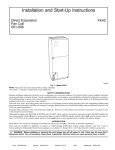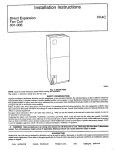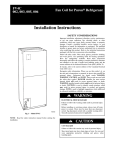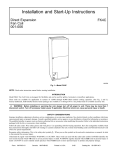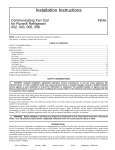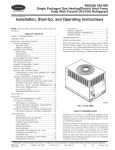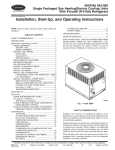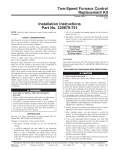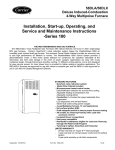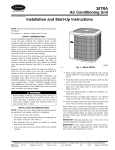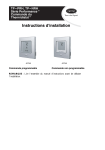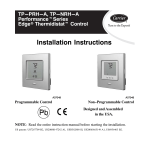Download Installation and Start-Up Instructions
Transcript
Installation and Start-Up Instructions Direct Expansion Fan Coil 001-006 FK4C A98023 Fig. 1—Model FK4C NOTE: Read entire instruction manual before starting installation. This symbol → indicates a change from the last publication. SAFETY CONSIDERATIONS Improper installation, adjustment, alteration, service, maintenance, or use can cause explosion, fire, electrical shock or other conditions which may cause personal injury or property damage. Consult a qualified installer, service agency, or your distributor or branch for information or assistance. The qualified installer or agency must use factory-authorized kits or accessories when modifying this product. Refer to the individual instructions packaged with the kits or accessories when installing. Follow all safety codes. Wear safety glasses and work gloves. Use quenching cloth for brazing operations. Have fire extinguisher available. Read these instructions thoroughly and follow all warnings or cautions attached to the unit. Consult local building codes and National Electrical Code (NEC) for special requirements. . When you see this symbol on the unit and in instructions or manuals, be alert Recognize safety information. This is the safety-alert symbol to the potential for personal injury. Understand the signal words DANGER, WARNING and CAUTION. These words are used with the safety-alert symbol. DANGER identifies the most serious hazards which will result in severe personal injury or death. WARNING signifies hazards which could result in personal injury or death. CAUTION is used to identify unsafe practices which would result in minor personal injury or product and property damage. WARNING: Before installing or servicing fan coil, always turn off all power to unit. There may be more than 1 disconnect switch. Turn off accessory heater power if applicable. Electrical shock can cause personal injury or death. INTRODUCTION Model FK4C Fan Coil units are designed for flexibility and can be used for upflow, horizontal, or downflow applications. These units are available for application in systems of 18,000 through 60,000 Btuh nominal cooling capacities. Factory-authorized, field-installed electric heater packages are available in 5 through 30 kw. See Product Data for available accessory kits. Form: IM-FK4C-06 Cancels: IM-FK4C-05 Printed in U.S.A. 2-99 Catalog No. 63FK-4C2 INSTALLATION PROCEDURE 1—CHECK EQUIPMENT Unpack unit and move to final location. Remove carton taking care not to damage unit. Inspect equipment for damage prior to installation. File claim with shipping company if shipment is damaged or incomplete. Locate unit rating plate which contains proper installation information. Check rating plate to be sure unit matches job specifications. PROCEDURE 2—MOUNT FAN COIL Unit can stand or lie on floor, or hang from ceiling or wall. Allow space for wiring, piping, and servicing unit. IMPORTANT: When unit is installed over a finished ceiling and/or living area, building codes may require a field-supplied secondary condensate pan to be installed under the entire unit. Some localities may allow as an alterative the running of a separate, secondary condensate line. Consult local codes for additional restrictions or precautions. When installing any fan coil over a finished ceiling and/or living area, installation of a secondary drain pan under entire unit to avoid damage to ceiling is recommended. FK4C Fan Coils can be installed for upflow and horizontal-left applications as factory shipped. Units can be installed for horizontal-right applications with field modifications. Units may be converted for downflow applications using factory-authorized accessory kit. NOTE: To ensure proper drainage for horizontal installations, unit must be installed so it is within 1/8 in. level of the length and width of unit. A. Upflow Installation If return air is to be ducted, install duct flush with floor. Set unit on floor over opening. Only use return-air opening provided. All return air must pass through the coil. (See Fig. 2.) B. Modular Units The FK4C Fan Coil in size 006 is a 2-piece modular unit. Modular construction allows installer to disassemble unit into 2 components, coil box and blower box, for ease of installation. (See Fig. 3.) To disassemble unit, remove rear corner brackets by removing 2 screws which secure brackets. (See Fig. 3.) Remove either 2 screws in each front corner of coil box, or 2 screws in blower box. Do not remove all 4 screws in each corner. (See Fig. 3.) Sections may now be separated by lifting top section from lower section. To reassemble, reverse above procedure. Be certain to reinstall all fasteners when reassembling. C. Horizontal Installations Be sure installation complies with all applicable building codes that may require installation of a secondary condensate pan. 1. Arrange support for unit by setting it in or above secondary condensate pan. 2. When suspending unit from ceiling, dimples in casing indicate proper location of screws for mounting metal support straps. (See Fig. 4.) POWER ENTRY OPTIONS FIELD SUPPLIED SUPPLY DUCT LOW VOLT ENTRY OPTIONS 24-IN. FRONT SERVICE CLEARANCE UNIT 001 003 A COIL UNITS UPFLOW/DOWNFLOW SECONDARY DRAIN A 17 In. 19 In. 1 1⁄2″ UPFLOW/DOWNFLOW PRIMARY DRAIN 19″ A 2 1⁄2″ FIELD MODIFIED SIDE RETURN LOCATION FOR SLOPE COIL UNITS ONLY UPFLOW/DOWNFLOW SECONDARY DRAIN UPFLOW/DOWNFLOW PRIMARY DRAIN FIELD SUPPLIED RETURN PLENUM A95621 Fig. 2—Slope Coil Unit in Upflow Application —2— BLOWER BOX 2 SCREWS 2 SCREWS REAR CORNER BRACKET 2 SCREWS COIL BOX A95293 Fig. 3—Modular Unit Assembly D. Horizontal-Right Conversion of Units with Slope Coils → NOTE: The TXV sensing bulb must be insulated on slope coils in horizontal right and downflow applications. Failure to insulate bulb will result in performance loss. To convert units for horizontal right installations: 1. Remove blower and coil access panels and fitting panel. (See Fig. 5.) 2. Remove screw securing coil assembly to right side casing flange. 3. Remove coil assembly. 4. Insulate TXV sensing bulb with cork tape or other permanent insulating material. (See Fig. 5.) 5. Lay fan coil on its right side and reinstall coil assembly with condensate pan down. (See Fig. 5.) 6. Attach coil to casing flange using previously removed coil mounting screw. 7. Reinstall access panels and fitting panel, aligning holes with tubing connections and condensate pan connections. Make sure liquid and suction tube grommets are in place to prevent air leaks and cabinet sweating. Install grommets after brazing. E. Horizontal Right Conversion of Units With A-Coil To convert units for horizontal right installations: 1. Remove blower and coil access panels. (See Fig. 6.) 2. Remove metal clip securing fitting panel to condensate pan. Remove fitting panel. 3. Remove 2 snap-in clips securing A-coil in unit. 4. Slide coil and pan assembly out of unit. 5. Remove horizontal drain pan support bracket from coil support rail on left side of unit and reinstall on coil support rail on right side of unit. 6. Convert air-seal assembly for horizontal right. a. Remove air-seal assembly from coil by removing 4 screws. b. Remove air splitter (B) from coil seal assembly by removing 3 screws. (See Fig. 6—factory-shipped inset.) c. Remove filler plate (A) and install air splitter (B) in place of filler plate. d. Install filler plate (A) as shown in horizontal right application. e. Remove condensate troughs (C) and install on opposite tube sheets. f. Install hose onto plastic spout. 7. Install horizontal pan on right side of coil assembly. 8. Slide coil assembly into casing. Be sure coil bracket on each corner of vertical pan engages coil support rails. —3— A-COIL HORIZONTAL LEFT SECONDARY DRAIN FIELD SUPPLIED HANGING STRAPS PRIMARY DRAIN 24-IN. FRONT SERVICE CLEARANCE (FULL FACE OF UNIT) UNIT LOW VOLT ENTRY OPTIONS 1 3/4 IN. FILTER ACCESS CLEARANCE PRIMARY DRAIN SECONDARY DRAIN POWER ENTRY OPTIONS A95292 Fig. 4—Slope Coil in Horizontal-Left Application BLOWER ASSEMBLY COIL MOUNTING SCREW COIL SUPPORT RAIL SLOPE COIL SKI DRAINPAN PRIMARY DRAIN REFRIGERANT CONNECTIONS TXV SENSING BULB MUST BE INSULATED OVERFLOW HOLE SECONDARY DRAIN A99033 → Fig. 5—Slope Coil in Horizontal-Right Application 9. Reinstall 2 snap-in clips to correctly position and secure coil assembly in unit. Be sure clip with large offset is used on right side of unit to secure horizontal pan. 10. Remove 2 oval coil access panel plugs and reinstall into holes on left side of coil access panel and fitting panel. 11. Remove insulation knockouts on right side of coil access panel. 12. Reinstall access and fitting panels, aligning holes with tubing connections and condensate pan connections. Be sure to reinstall metal clip between fitting panel and vertical condensate pan. —4— A REFRIGERANT CONNECTIONS AIR SEAL ASSEMBLY HORIZONTAL RIGHT APPLICATION COIL SUPPORT RAIL B C COIL BRACKET DRAIN PAN SUPPORT BRACKET A COIL SUPPORT RAIL FACTORY SHIPPED HORIZONTAL LEFT APPLICATION COIL BRACKET HORIZONTAL DRAIN PAN PRIMARY DRAIN HORIZONTAL RIGHT SECONDARY DRAIN HORIZONTAL RIGHT PRIMARY DRAIN HORIZONTAL LEFT SECONDARY DRAIN HORIZONTAL LEFT B C A95286 Fig. 6—A-Coil in Horizontal Right-Application Make sure liquid and suction tube grommets are in place to prevent air leaks and cabinet sweating. F. Downflow Installations To convert units for downflow applications, refer to Installation Instructions supplied with kit for proper installation. For FK4C unit sizes 001 and 003, use kit Part No. KFADC0201SLP. For FK4C unit sizes 002, 005, and 006 use kit Part No. KFADC0401ACL. Use fireproof resilient gasket, 1/8- to 1/4-in. thick, between duct, unit, and floor. PROCEDURE 3—AIR DUCTS Connect supply-air duct over outside of 3/4-in. flange provided on supply-air opening. Secure duct to flange with proper fasteners for type of duct used, and tape duct-to-unit joint. Duct connection flanges are provided on unit air discharge connection. When using FK4C units with 20-, 24-, and 30-kw electric heaters, maintain a 1-in. clearance from combustible materials to discharge plenum and ductwork for a distance of 36 in. from unit. Use accessory downflow base to maintain proper clearance on downflow installations. Use flexible connectors between ductwork and unit to prevent transmission of vibration. When electric heater is installed, use heat resistant material for flexible connector between ductwork and unit at discharge connection. Ductwork passing through unconditioned space must be insulated and covered with vapor barrier. A. Ductwork Acoustical Treatment Metal duct systems that do not have a 90° elbow and 10 ft of main duct to first branch takeoff may require internal acoustical insulation lining. As an alternative, fibrous ductwork may be used if constructed and installed in accordance with the latest edition of SMACNA construction standard on fibrous glass ducts. Both acoustical lining and fibrous ductwork shall comply with National Fire Protection Association Standards 90A or B as tested by UL Standard 181 for Class 1 air ducts. PROCEDURE 4—ELECTRICAL CONNECTIONS A. Line-Voltage Connections Units with 15- and 20-kw heaters are factory wired for dual-circuit operation. When single-circuit operation is required, 24- and 30-kw heaters are field convertible, and 15- and 20-kw fused heaters require the use of factory-authorized adapter kit. Check all factory wiring per unit wiring diagram and inspect factory wiring connections to be sure none were loosened in transit or installation. WARNING: Before installing or servicing system, always turn off all power to system. There may be more than 1 disconnect switch. Turn off accessory heater power if applicable. Electrical shock can cause personal injury or death. CAUTION: If a disconnect switch is to be mounted on the unit, select a location where drill or fastener will not contact electrical or refrigerant components. Electrical shock can cause personal injury or death. NOTE: Before proceeding with electrical connections, make certain that supply voltage, frequency, and phase are as specified on unit rating plate. Be sure that electrical service provided by the utility is sufficient to handle the additional load imposed by this equipment. See unit wiring label for proper field high- and low-voltage wiring. Make all electrical connections in accordance with NEC and any local codes or ordinances that may apply. Use copper wire only. The unit must have a separate branch electric circuit with a field-supplied disconnect switch located within sight from, and readily accessible from the unit. —5— INDOOR CONTROL HEAT STAGE 2 O/W2 FAN COIL Y1 HEAT STAGE 1 W/W1 W1 Y/Y2 Y/Y2 FAN G G 24 VAC HOT R R O DEHUMIDIFY DHUM 24 VAC COMM HUMIDIFY N/A OUTDOOR SENSOR CONNECTION C HUM INDOOR CONTROL W2 N/A Y1/W2 COOL STAGE 1 1-SPEED AIR CONDITIONER REMOVE J2 JUMPER FOR HEAT STAGING Y HEAT STAGE 2 O/W2 W2 HEAT STAGE 1 W/W1 W1 COOL STAGE 1 Y1/W2 C Y1 Y/Y2 Y2 FAN G G 24 VAC HOT R R DEHUMIDIFY DHUM C 24 VAC COMM HUMIDIFY HUMIDIFIER (24 VAC) B S1 Y1 O DH OUTDOOR SENSOR S2 REMOVE J2 JUMPER FOR HEAT STAGING Y/Y2 COOL STAGE 2 REMOVE J1 JUMPER FOR DEHUMIDIFY MODES 2-SPEED AIR CONDITIONER FAN COIL C HUM N/A B OUTDOOR SENSOR CONNECTION S1 DH R REMOVE J1 JUMPER FOR DEHUMIDIFY MODES C C HUMIDIFIER (24 VAC) OUTDOOR SENSOR S2 A98477 A98478 Fig. 7—FK4C Fan Coil Wiring with 1-Speed Air Conditioner Fig. 8—FK4C Fan Coil Wiring with 2-Speed Air Conditioner All units are shipped with power plug and stripped leads for connection of field wiring to units without electric heat. 1. Connect 208/230v power leads from field disconnect to yellow and black-stripped leads. 2. Connect ground wire to unit ground lug. 3. If unit contains accessory electric heater, remove and discard power plug from fan coil and connect male plug from heater to female plug from unit wiring harness. (See Electric Heater Installation Instructions.) B. 24-V Control System Connections to Unit Printed-Circuit Board (PCB) Refer to unit wiring instructions for recommended wiring procedures. Use No. 18 AWG color-coded, insulated (35°C minimum) wires to make low-voltage connections between thermostat and unit. If thermostat is located more than 100 ft from unit (as measured along the low-voltage wires), use No. 16 AWG color-coded, insulated (35°C minimum) wires. PCB is circuited for single-stage heater operation. When additional heater staging is desired using 2-stage or outdoor thermostats, remove Jumper J2 on PCB. Connect low-voltage leads to thermostat and outdoor unit. (See Fig. 7, 8, 9 or 10.) C. Intelligent Heat Option Intelligent Heat staging of the electric heat package is possible when the FK4C is installed as a part of a single-speed heat pump system using a corporate 2-speed programmable thermostat (model TSTATXXP2S01-B), Thermidistat™ Control, or zoning control, and any 1 of the following electric heat packages: relay heaters KFCEH1401N09, KFCEH1501F15, KFCEH1701C15, KFCEH1801F20, KFCEH1901C20, KFCEH2101F24, OR KFCEH2201F30. Complete system low-voltage wiring as shown in Fig. 7, 8, 9, or 10. NOTE: Where local codes require thermostat wiring be routed through conduit or raceways, splices can be made inside the fan coil unit. All wiring must be NEC Class l and must be separated from incoming power leads. A factory-authorized disconnect kit is available for installation of 0- through 10-kw applications. When electric heat packages with circuit breakers are installed, the circuit breaker can be used as a disconnect. Transformer is factory wired for 230-v operation. For 208-v applications, disconnect black wire from 230-v terminal on transformer and connect it to 208-v terminal. (See Fig. 11.) The secondary circuit of transformer is protected by a 5-amp fuse mounted on printed-circuit board. IMPORTANT: Do not use outdoor thermostat with Intelligent Heat. D. Comfort Options —Warmer Heating and Super Dehumidify Warmer heating and Super Dehumidify options are possible when the FK4C Fan Coil is installed with an outdoor temperature sensor (needed for warmer heating only) and a corporate Thermidistat™ Control. See Procedure 8, I. Comfort Options for complete description of these features. Complete the system low-voltage wiring as shown in Fig. 7, 8, 9, or 10. —6— INDOOR CONTROL RVS COOLING O/W2 FAN COIL W2 HEAT STAGE 2 W/W1 W1 Y/Y2 Y/Y2 FAN G G 24 VAC HOT R R Y1 DEHUMIDIFY DHUM 24 VAC COMM HUMIDIFY RVS HEATING OUTDOOR SENSOR CONNECTION C HUM INDOOR CONTROL O O HEAT STAGE 3 Y1/W2 HEAT/COOL STAGE 1 1-SPEED HEAT PUMP W2 Y R REMOVE J1 JUMPER FOR DEHUMIDIFY MODES O O HEAT/COOL Y1/W2 STAGE 1 Y1 Y1 HEAT STAGE 3 W/W1 W1 HEAT/COOL STAGE 2 Y/Y2 W2 W2 REMOVE J2 JUMPER FOR HEAT STAGING FAN G Y/Y2 24 VAC HOT R G R DH DEHUMIDIFY DHUM C C 24 VAC COMM HUMIDIFIER (24 VAC) HUMIDIFY B S1 O/W2 RVS COOLING REMOVE J2 JUMPER FOR HEAT STAGING OUTDOOR SENSOR S2 2-SPEED HEAT PUMP FAN COIL C HUM RVS HEATING B OUTDOOR SENSOR CONNECTION S1 DH Y2 R REMOVE J1 FOR DEHUMIDIFY MODES W3 C C HUMIDIFIER (24 VAC) OUTDOOR SENSOR S2 A98475 A98476 Fig. 10—FK4C Fan Coil Wiring with 2-Speed Heat Pump Fig. 9—FK4C Fan Coil Wiring with 1-Speed Heat Pump SECONDARY YEL BLK 230 208 C BRN RED PRIMARY A94067 Fig. 11—Transformer Connections E. Ground Connections Use UL listed conduit and conduit connector to connect supply wire(s) to unit and obtain proper grounding. Grounding may also be accomplished by using grounding lug provided in control box. Use of dual or multiple supply circuits will require grounding of each circuit to ground lugs provided on unit and heaters. WARNING: The cabinet must have an uninterrupted or unbroken ground according to NEC, ANSI/NFPA 70 and local codes to minimize personal injury if an electrical fault should occur. The ground may consist of electrical wire or metal conduit when installed in accordance with existing electrical codes. Failure to follow this warning could result in an electrical shock, fire, or death. PROCEDURE 5—REFRIGERANT TUBING CONNECTION AND EVACUATION This fan coil is supplied with an R-22 TXV factory installed. If installing with a Puron system, the TXV must be replaced using a Puron (R-410A) TXV unit. See outdoor unit literature for correct TXV Kit number. See Dimensional Drawing for tube connection sizes, type, and locations. Use accessory tubing package or field-supplied tubing of refrigerant grade. Insulate entire suction tube if field-supplied tubing is used. Tubing package has an insulated suction tube. Do not use damaged, dirty, or contaminated tubing because it may plug refrigerant flow control device. When tubing package is used and sweat connections are made within 60 sec, coil and tubing system does not require evacuation. Always evacuate coil and field-supplied tubing to 500 microns before opening outdoor unit service valves. —7— UNIT 2 1⁄4″ 2 1⁄4″ DO NOT USE SHALLOW RUNNING TRAPS! A95321 A95320 Fig. 13—Insufficient Condensate Trap Fig. 12—Recommended Condensate Trap CAUTION: A brazing shield MUST be used when tubing sets are being brazed to the unit connections to prevent damage to the unit surface. Braze with Sil-fos or Phos-copper on copper to copper joints. Wrap a wet cloth around rear of fitting to prevent damage to TXV. CAUTION: To prevent damage to thermostatic expansion valve, remove sensor bulb from vapor tube while brazing or soldering vapor connections. Units have sweat suction and liquid tube connections. Make suction tube connection first. 1. Cut tubing to correct length. 2. Insert tube into sweat connection on unit until it bottoms. 3. Braze with Sil-fos or Phos-copper. CAUTION: Wrap a wet cloth around rear of fitting to prevent damage to factory-made joints. 4. Evacuate coil and tubing system to 500 microns using deep vacuum method. PROCEDURE 6—CONDENSATE DRAIN Units are equipped with primary and secondary 3/4-in. FPT drain connections. For proper condensate line installation see Fig. 2, 4, 5, and 6. To prevent property damage and achieve optimum drainage performance, BOTH primary and secondary drain lines should be installed and include properly sized condensate traps. (See Fig. 12 and 14.) Factory-approved condensate traps are available (Kit No. KFAET0125ETK). Be sure to install plastic push-in plugs in unused condensate drain fittings. It is recommended that PVC fittings be used on the plastic condensate pan. Do not over-tighten. Finger-tighten plus 1-1/2 turns. Use pipe dope. CAUTION: Shallow running taps are inadequate and DO NOT allow proper condensate drainage. (See Fig. 13.) NOTE: When connecting condensate drain lines, avoid blocking filter access panel. Prime both primary and secondary condensate traps after connecting to drain pan. NOTE: If unit is located in or above a living space where damage may result from condensate overflow, a field-supplied external condensate pan should be installed underneath the entire unit, and a secondary condensate line (with appropriate trap) should be run from the unit into the pan. Any condensate in this external condensate pan should be drained to a noticeable place. As an alternative to using an external condensate pan, some localities may allow the running of a separate 3/4-in. condensate line (with appropriate trap) to a place where the condensate will be noticeable. The owner of the structure must be informed that when condensate flows from the secondary drain or external condensate pan, the unit requires servicing, or water damage will occur. Install traps in the condensate lines as close to the coil as possible. (See Fig. 14.) Make sure that the outlet of each trap is below its connection to the condensate pan to prevent condensate from overflowing the drain pan. Prime all traps, test for leaks, and insulate traps if located above a living area. Condensate drain lines should be pitched downward at a minimum of 1 in. for every 10 ft. of length. Consult local codes for additional restrictions or precautions. CAUTION: Never operate unit without a filter or with filter access door removed. Damage to blower motor or coil can result. IMPORTANT: Factory authorized filters must be used when locating the filter inside the unit. (See Table 1.) For those applications where access to an internal filter is impractical, a field-supplied filter must be installed in the return duct system. PROCEDURE 7—UNIT START-UP Refer to outdoor unit Installation Instructions for system start-up instructions and refrigerant charging method details. —8— FILTER ACCESS PANEL SECONDARY DRAIN REQUIRED (USE FACTORY KIT OR FIELD-SUPPLIED TRAP) PRIMARY TRAP REQUIRED (USE FACTORY KIT OR FIELD-SUPPLIED TRAP) A99040 Fig. 14—Condensate Trap and Unit Table 1—Filter Kits FILTER KIT (12 PACK) PART NUMBER KFAFK0212MED KFAFK0312LRG KFAFK0412XXL SIZE USED WITH 001, 002, 003, 005 006 PROCEDURE 8—EASY SELECT CONFIGURATION TAPS EASY SELECT™ taps are used by the installer to configure a system. ICM2 uses the selected taps to modify its operation to a pre-programmed table of airflows. Airflows are based on system size or mode of operation and those airflows are modified in response to other inputs such as the need for de-humidification. (See Fig. 15 and 16.) The FK4C Fan Coil must be configured to operate properly with system components with which it is installed. To successfully configure a basic system (see information printed on circuit board label located next to select pins), move the 6 select wires to the pins which match the components used. A. AUX HEAT KW/CFM – Select heater range for size of electric heater installed Installer must select the auxiliary heat airflow approved for application with kw size heater installed. If no heater is installed, this step can be skipped. Each select pin is marked with a range of heaters for which airflow, also marked, is approved. For increased comfort select the narrowest kw range matching the heater size, for example, 0-10 for 10-kw heater. This airflow must be greater than the minimum CFM for electric heater application with the size system installed for safe and continuous operation. (See Tables 3 and 4 for airflow delivery and minimum CFM.) Note that airflow marked is the airflow which will be supplied in emergency heat mode and heating mode on air conditioners when electric heat is the primary heating source. In heat pump heating mode when electric heaters are energized, the ICM2 will run the higher of heat pump heating airflow and electric heater airflow to ensure safe heater operation. The factory selection is the largest heater range approved. (See Fig. 15, A as indicated.) B. AC/HP SIZE – Select system size installed The factory setting for air conditioner or heat pump size is the largest unit meant for application with the model of fan coil purchased. Installer needs to select air conditioner or heat pump size to ensure that airflow delivered falls within proper range for the size unit installed. This applies to all operational modes with the exception of electric heat modes. (See Fig. 15, B as indicated.) C. SYSTEM TYPE – Select system type installed AC or HP The type of system must be selected: 1. AC — Air conditioner 2. HP-COMFORT — Heat Pump Comfort provides approximately 315 CFM per ton for higher normal heating air delivery temperature. Provides approximately 350 CFM per ton cooling airflow for good humidity removal. 3. HP-EFF — Heat Pump Efficiency provides same airflow for heating and cooling modes to increase overall HP efficiency; approximately 350 CFM per ton. The factory setting is AC. (See Fig. 15, C as indicated.) D. AC/HP CFM ADJUST – Select Medium, Low, or High airflow To provide airflow at rates described above, the AC/HP ADJUST select is factory set to the nominal (nom) tap. The adjust selections HI/LO will regulate airflow supplied for all operational modes, except non-heat pump heating modes. HI provides 15 percent airflow over nominal unit size selected and LO provides 10 percent airflow below nominal unit size selected. The adjust selection options are provided to adjust airflow supplied to meet individual installation needs for such things as noise, comfort, and humidity removal. (See Fig. 15, D as indicated.) —9— LOW VOLTAGE TERMINAL BLOCK PRINTED CIRCUIT BOARD SEC1 SEC2 EASY SELECT J1 DH TM R AUX HEAT KW/CFM KW CFM A 0-20 1100 0-15 875 0-10 675 0-5 625 J2 W1 VIO W2 AC/HP SIZE 036 B 030 024 018 Y1 BLU SYSTEM TYPE AC C HP-COMFORT HP-EFF Y/Y2 ORN AC/HP CFM ADJUST NOM D LO G HI BLK O ON/OFF DELAY 0 90 E 30 90 0 0 C ENH WHT F LO CONTINUOUS FAN MED HI AUX1 HUM1 AUX2 HUM2 YEL YEL CEBD430226-01B CESS430226-01B 24VAC HEATER/MOTOR GRY MOLEX 12-PIN CONNECTOR A95275 Fig. 15—Detail of FK4C Printed-Circuit Board E. ON/OFF DELAY – Select desired time delay profile Four motor operation delay profiles are provided to customize and enhance system operation. (See Fig. 15, E as indicated) Selection options are: 1. The standard 90 sec off delay (Factory setting) at 100 percent airflow. 2. No delay option used for servicing unit or when a thermostat is utilized to perform delay functions. 3. A 30 sec on delay with no airflow/ 90 sec off delay at 100 percent airflow profile is used when it is desirable to allow system coils time to heat-up/cool-down in conjunction with the airflow. 4. ENH, enhanced selection, provides a 30 sec on delay with no airflow/ plus 150 sec at 70 percent airflow/ no off delay for added comfort. This profile will minimize cold blow in heat pump operation and could enhance system efficiency. F. CONTINUOUS FAN — Select desired fan speed when thermostat is set on continuous fan 1. LO speed — factory setting, 50 percent cooling mode airflow 2. MED speed — move connector to MED, 65 percent cooling mode airflow. 3. HI speed — move connector of HI, 100 percent cooling mode airflow. (See Fig. 15, F as indicated.) G. LOW-VOLTAGE CIRCUIT FUSING AND REFERENCE The low-voltage circuit is fused by a board-mounted 5-amp automotive fuse placed in series with the transformer SEC2 and the R circuit. The C circuit of the transformer is referenced to chassis ground through a printed circuit run at SEC1 connected to metal standoff marked with ground symbol. H. BASIC FAN COIL CONFIGURATION The following basic configuration of the fan coil will provide ARI rated performance of the heat pump. 1. AUX HEAT KW/CFM — Select the heater range for the size electric heater installed. 2. AC/HP SIZE — Select system size installed. 3. SYSTEM TYPE — Select system type HP-EFF. 4. AC/HP CFM ADJUST — Select NOM. 5. ON/OFF DELAY — Select 0/90 profile. 6. CONTINUOUS FAN — Select desired fan speed when thermostat is set to continuous fan. I. COMFORT OPTIONS—WARMER HEATING AND SUPER DEHUMIDIFY (See Fig. 20 for Quick Reference Guide) Warmer heating and Super Dehumidify options are possible when the FK4C Fan Coil is installed with an outdoor temperature sensor and a corporate Thermidistat™ Control. —10— SEC1 SEC2 EASY SELECT J1 DH TM R AUX HEAT KW/CFM 0-30 1075 0-20 875 0-10 725 0-5 625 J2 W1 VIO W2 AC/HP SIZE 036 030 024 018 Y1 BLU SYSTEM TYPE AC HP-COMFORT HP-EFF Y/Y2 ORN AC/HP CFM ADJUST NOM LO G HI BLK O ON/OFF DELAY 0 90 30 90 0 0 C ENH WHT LO CONTINUOUS FAN MED HI AUX1 HUM1 AUX2 HUM2 YEL YEL CEBD430226-01B CESS430226-01B 24VAC HEATER/MOTOR GRY 12-PIN MATE-N-LOCK ELECTRIC HEAT CONNECTOR A95276 Fig. 16—PCB Wiring Arrangement NOTE: The FK4C Fan Coil provides better than average humidity control and heated air temperature. This configuration will improve the comfort provided by the heat pump system if more humidity removal or if warmer heating air is desired. While providing this improved comfort, the heat pump system will operate efficiently, but not at the published HSPF or ARI SEER efficiency. The following fan coil configuration is recommended for maximum heating and cooling/dehumidifying comfort: (See Fig. 15.) 1. AUX HEAT KW/CFM — Select narrowest heater range to match size of electric heater installed (skip this step if no heater is installed). 2. AC/HP SIZE — Select system size installed. 3. SYSTEM TYPE — Select system type HP-COMFORT (for heat pump system) or AC (for air conditioner system). 4. AC/HP CFM ADJUST — Select LO. 5. ON/OFF DELAY — Select ENH profile. 6. CONTINUOUS FAN — Select desired fan speed when thermostat is set to continuous fan. 7. If the fan coil is installed with Intelligent Heat Staging capable electric heaters, remove jumper J2. (See Fig. 15.) NOTE: If configuring to run warmer heating, do not remove jumper J2 when using 5-, 8-, or 10-kw heaters. 8. Remove jumper J1 to activate dehumidify modes. —11— 9. Wire low voltage connections as shown in Figs. 7, 8, 9, or 10. 10. Configure Thermidistat (or other warmer heating capable indoor control) following its installation instructions for Super Dehumidify operation. This configuration provides the following comfort enhancements: a. A 30 second blower on delay with 150 seconds at 70 percent airflow to allow the indoor coil to warm up or cool down before the blower is asked to deliver 100 percent airflow reducing the cold blow sensation at start up in heating and allowing the indoor coil to more quickly reach wet coil operating conditions in cooling. b. No blower off delay eliminates cold blow which may be associated with running the blower after shut down of the compressor and avoids re-evaporation of condensed moisture after cooling/dehumidifying operation. c. Lower airflow while the compressor is running to reduce draft effects and increase heating air temperature and improved humidity control during cooling operation. d. Intelligent Staging of the electric heater elements to more closely match heating load requirements and provide more consistent heating air temperatures. PROCEDURE 9—ACCESSORY INSTALLATION A. Accessory Electric Heaters Electric heaters may be installed with the FK4C Fan Coil per instructions supplied with the electric heater package. See unit rating plate for factory-approved electric heater kits. NOTE: Units installed without electric heat should have a field-supplied sheet metal block-off plate covering the heater opening. This reduces air leakage and formation of exterior condensation. B. Electronic Air Cleaner Connections Because the ICM2 blower motor used in the FK4C Fan Coil is controlled by low-voltage signals, a switched 230-vac electronic air cleaner power signal is not available. This signal is replaced by a 24-vac signal which is provided at PCB terminals AUX1 and AUX 2 (See Fig. 15 and 16.) This signal is present whenever the G thermostat signal is present (heat pump heating, cooling and continuous blower modes). When the FK4C Fan Coil is installed with an electronic air cleaner, use EAC relay kit Part No. KFAIR0201ACR or a field- supplied 24-vac relay. If EAC relay is field supplied, use field-supplied wiring, terminations and wire per the EAC wiring schematic. (See Fig. 17.) C. Humidifier/Humidistat Connections Easy Select Board terminals HUM1 and HUM2 are provided for direct connection to the low-voltage control of a humidifier through a standard humidistat. (See Fig. 16.) These terminals are energized with 24vac when G thermostat signal is present. (See Fig. 18.) Alternately, the 24-vac signal may be sourced from the W and C terminal block connections when electric heaters are used as primary heating source. When using a Thermidistat™ Control the 24-vac signal may be sourced directly from the Thermidistat HUM terminal. (See Figs. 7, 8, 9, and 10.) D. Dehumidify Capability with Standard Humidistat Connection Latent capacities for systems using the FK4C Fan Coil are better than average systems. If increased latent capacity is an application requirement, the field wiring terminal block provides connection terminals for use of standard humidistat. The FK4C Fan Coil will detect humidistat contacts opening on increasing humidity and reduce its airflow to approximately 80 percent of nominal cooling mode airflow. This reduction will increase system latent capacity until humidity falls to a level which causes humidistat to close its contacts. When contacts close, airflow will return to 100 percent of selected cooling airflow. To activate this mode, remove Jumper J1 and wire in a standard humidistat. (See Fig. 19.) E. Dehumidify and Super Dehumidify Capabilities This model fan coil is capable of responding to a signal from indoor system control (thermostat, thermidistat, zoning control) to operate in comfort control modes such as Super Dehumidify Mode. Consult literature provided with indoor system control to determine if these operating modes are available, and to see control set up instructions. No special setup or wiring of fan coil is required. WHT BLK GRN RED RED 24 VAC RELAY NO BLK 230 VAC OR 115 VAC BRANCH CKT GND HOT NEUT FAN COIL AUX1 AUX2 (C) (G) WHT TO EAC BLK COM A98625 → Fig. 17—EAC Relay Wiring Schematic —12— EASY SELECT BOARD TERMINAL BLOCK HUMIDISTAT HUM 1 (C) J1 24-VAC DH HUMIDISTAT TO HUMIDIFIER REMOVE JUMPER HUM 2 (G) R HUMIDIFIER WIRING A95317 A95316 Fig. 19—Humidistat Wiring for De-Humidify Mode Fig. 18—Humidifier Wiring PROCEDURE 10—FK4C FAN COIL SEQUENCE OF OPERATION The FK4C will supply airflow in a range which is more than twice the range of a standard fan coil. It is designed to provide nominal cooling capacities at a 50°F evaporator temperature and the required airflow which enables it to match with 4 air conditioner or heat pump system sizes. Table 2 outlines the CFM range for the different FK4C Fan Coil sizes. Table 2–CFM Range for FK4C Units FAN COIL SIZE FK4CNF001, 002 FK4CNF003 FK4CNF005 FK4CNB006 A. SYSTEM SIZES 018, 024, 030, 036 024, 030, 036, 042 030, 036, 042, 048 036, 042, 048, 060 CFM RANGE 450-1275 525-1475 550-1700 550-2150 Continuous Fan 1. Thermostat closes circuit R to G The blower runs at continuous fan airflow. B. Cooling Mode — Single speed or 2-speed high 1. If indoor temperature is above temperature set point and humidity is below humidity set point, thermostat closes circuits R to G, R to Y/Y2 and R to O The fan coil delivers single speed cooling airflow. 2. Thermostat closes circuits R to G, R to Y1, R to Y2 and R to O The fan coil delivers 2-speed high cooling airflow. C. Cooling Mode — 2-speed low 1. If indoor temperature is above temperature set point and humidity is below humidity set point, thermostat closes circuits R to G, R to Y1 and R to O The fan coil delivers 2-speed low cooling airflow. D. Cooling Mode — Dehumidification 1. If indoor temperature is above temperature set point and humidity is above humidity set point, thermostat or Thermidistat™ Control closes circuits R to G, R to O, and R to Y/Y2 (or R to Y1 for 2-speed low), and humidistat or Thermidistat opens R to DH The fan coil delivers airflow which is approximately 80 percent of the nominal cooling airflow to increase the latent capacity of the system. E. Cooling Mode — Super Dehumidify Operation (See Fig. 20 for Quick Reference Guide) NOTE: The indoor control used, such as a Thermidistat, must be capable of providing Super Dehumidify operation mode and control must be configured as outlined in its installation instructions. Consult indoor control literature to determine if control is capable of providing Super Dehumidify inputs and for configuration instructions. 1. If the indoor temperature is below the temperature set point and the humidity is above the humidity set point, the Thermidistat closes circuit R to O, opens circuits R to DH and R to G, and cycles circuit R to Y/Y2 (for single speed system R to Y1, or R to Y1 and Y/Y2 for 2-speed system). The ICM2 motor reads the G signal to the fan coil while the heat pump is operating, (circuit R to Y/Y2 for single speed system, R to Y1 or R to Y1 and Y/Y2 for 2-speed system, closed (24 vac)). If circuit R to G is closed (24 vac), the motor will deliver airflow at the full cooling or cooling plus dehumidify mode requested value. If circuit R to G is open (0 vac) for super dehumidify mode, the motor delivers reduced airflow to maximize the humidity removal of the system while minimizing overcooling. F. Electric Heat Heating Mode 1. Thermostat closes circuit R to W/W1, or W2 The fan coil delivers the selected electric heat airflow. G. Heat Pump Heating Mode — Single speed or 2-Speed High 1. Thermostat closes circuits R to G and R to Y/Y2 The fan coil delivers single speed heat pump heating airflow. —13— 2. Thermostat closes circuits R to G, R to Y1 and R to Y/Y2 The fan coil delivers 2-speed high heat pump heating airflow. H. Heat Pump Heating Mode — 2-speed low 1. Thermostat closes circuits R to G and R to Y1 The fan coil delivers 2-speed heat pump heating low airflow. I. Heat Pump Heating with Auxiliary Electric Heat 1. Thermostat closes circuits R to G, R to Y/Y2 and/or R to Y1 with R to W/W1 or W2 (and R to O in the case of defrost) In the event that electric heating is called for by the thermostat while the heat pump is also operating in either heating or defrost modes, the motor will modify its airflow output, if necessary, to provide an airflow which is defined as safe for the operation of the electric heater during heat pump operation. That airflow is the greater of the heat pump heating airflow and the electric heater only airflow. J. Heat Pump Heating with Thermidistat™ Control (See Fig. 20 for Quick Reference Guide) NOTE: The indoor control used, such as a Thermidistat, must be capable of providing warmer heating operation mode and control must be configured as outlined in its installation instructions. The system must be installed with appropriate outdoor temperature sensor. Consult indoor control literature to determine if control is capable of providing warmer heating control outputs and for configuration instructions. Consult indoor control and sensor instructions for installation and configuration details. 1. If the outdoor temperature is in the range of 10° to 40°F, the Thermidistat closes circuit R to Y/Y2 (for single speed system R to Y1, or R to Y1 and Y/Y2 for 2-speed system) and opens circuit R to G. The ICM2 motor reads the G signal to the fan coil. If circuit R to G is closed (24 vac), the motor will deliver airflow at the full heating requested value. If circuit R to G is open (0 vac) for maximum heating comfort, the motor delivers reduced airflow to maximize the temperature and minimize the draft effect of the heated air leaving the fan coil. Table 3—FK4C Airflow Delivery (CFM) FAN UNIT SIZE 001 002 003 UNIT FAN SIZE 005 006 OUTDOOR UNIT CAPACITY BTUH 18,000 24,000 30,000 36,000 24,000 30,000 36,000 42,000 OUTDOOR UNIT CAPACITY BTUH 30,000 36,000 42,000 48,000 36,000 42,000 48,000 60,000 ELECTRIC HEATER KW RANGE 0—5 LO 625 650 815 980 675 815 980 1140 NOM 625 725 905 1085 725 905 1085 1270 0—10 HI 625 835 1040 1250 835 1040 1250 1460 LO 675 * * 980 875 875 980 1140 NOM 675 725 905 1085 875 905 1085 1270 0—15 HI 675 835 1040 1250 875 1040 1250 1460 LO * 875 900 980 * 1100 1100 1140 NOM * 875 900 1085 * 1100 1100 1270 0—20 HI * 875 1040 1250 * 1100 1250 1460 LO * * 1100 1100 * * 1225 1225 HI * 1250 1460 1665 * 1525 1665 2085 LO * * 1500 1500 * * 1750 1750 NOM * * 1100 1100 * * 1225 1270 HI * * 1100 1250 * * 1250 1460 ELECTRIC HEATER KW RANGE 0—10 LO 975 980 1140 1305 1100 1140 1305 1630 NOM 975 1085 1270 1450 1100 1270 1450 1810 0—15 HI 1040 1250 1460 1665 1250 1460 1665 2085 LO 1100 1100 1140 1305 1350 1350 1350 1630 NOM 1100 1100 1270 1450 1350 1350 1450 1810 * Airflow not recommended for heater/system size. NOTE: LO, NOM, and HI refer to AC/HP CFM ADJUST selection. —14— 0—20 HI 1100 1250 1460 1665 1350 1460 1665 2085 LO * 1250 1250 1305 * 1525 1525 1630 NOM * 1250 1270 1450 * 1525 1525 1810 0—30 NOM * * 1500 1500 * * 1750 1810 HI * * 1500 1665 * * 1750 2085 Table 4—FK4C Minimum CFM for Electric Heater Application FAN COIL UNIT 001 002 003 005 006 HEAT PUMP UNIT SIZE Heater Only 018 024 030 036 Heater Only 024 030 036 042 Heater Only 030 036 042 048 Heater Only 036 042 048 060 5 625 625 650 800 970 675 675 800 975 1125 675 800 975 1125 1305 1050 1100 1125 1300 1625 8, 9, 10 625 625 725 875 970 700 875 875 975 1125 700 875 975 1125 1305 1050 1100 1125 1300 1625 CFM HEATER SIZE KW 15 725 — 875 875 970 1050 1050 1100 1100 1125 1050 1100 1100 1125 1305 1050 1350 1350 1350 1625 18, 20 875 — — 1040 1040 1050 — — 1225 1225 1050 — 1225 1225 1305 1050 1350 1350 1465 1750 24, 30 — — — — — — — — — — 1400 — — — 1400 1750 — — 1750 1750 NOTES: 1. Heater Only—Air conditioner with electric heater application. 2. These airflows are minimum acceptable airflows as UL listed. Actual airflow delivered will be per airflow delivery chart for Electric Heating Modes. CARE AND MAINTENANCE For continuing high performance, and to minimize possible equipment failure, it is essential that periodic maintenance be performed on this equipment. The only required maintenance that may be performed by the consumer is filter maintenance. WARNING: Disconnect all power to unit before servicing field wires or removing control package. The disconnect (when used) on access panel does not disconnect power to the line side of disconnect, but does allow safe service to all other parts of unit. If unit does not have a disconnect, disregard the foregoing. Instead, make sure that a disconnecting means is within sight from, and is readily accessible from, the unit. Disconnect all electrical power to unit before performing any maintenance or service on it. A failure to follow this warning can cause electrical shock, fire, personal injury, or death. The minimum maintenance requirements for this equipment are as follows: 1. Inspect and clean or replace air filter each month or as required. 2. Inspect cooling coil, drain pan, and condensate drain each cooling season for cleanliness. Clean as necessary. An inspection port is provided on all A-coil delta plates. Remove plastic plug to inspect. 3. Inspect blower motor and wheel for cleanliness each heating and cooling season. Clean as necessary. 4. Inspect electrical connections for tightness and controls for proper operation each heating and cooling season. Service as necessary. Consult fan coil service manual available from equipment distributor for maintenance procedures. WARNING: As with any mechanical equipment, personal injury can result from sharp metal edges, etc, therefore, care should be taken when removing parts. Using Owner’s/User Manual furnished in outdoor unit, the installing technician should explain to the consumer system operation with particular emphasis on indoor fan coil operation sounds and filter maintenance. —15— QUICK REFERENCE GUIDE SET-UP INSTRUCTIONS FOR WARMER HEATING TEMPERATURES AND SUPER HUMIDITY CONTROL IN COOLING EASY SELECT BOARD LOW VOLTAGE TERMINAL BLOCK SEC1 SEC2 EASY SELECT J1 DH TM R AUX HEAT KW/CFM 0-30 1075 A 0-20 875 0-10 725 0-5 625 J2 W1 VIO W2 AC/HP SIZE 036 B 030 024 018 Y1 BLU SYSTEM TYPE AC C HP-COMFORT HP-EFF Y/Y2 ORN AC/HP CFM ADJUST NOM D LO HI O ON/OFF DELAY 0 90 30 90 0 0 C ENH WHT LO F CONTINUOUS FAN MED HI AUX1 HUM1 AUX2 HUM2 YEL YEL CEBD430226-01B CESS430226-01B 24VAC HEATER/MOTOR THERMIDISTAT™ CONTROL SETTINGS G BLK E 1. Configuration Taps (See Installation Instructions, for detailed description.) A. AUX HEAT - Set for heater size (Ex: 0-10 for 10 kw) B. AC/HP SIZE - Set for size of outdoor unit C. SYSTEM TYPE - Select "HP COMFORT" D. AC/HP CFM ADJUST - Select "LO" E. ON/OFF DELAY - Select "ENH" F. CONTINUOUS FAN - Select desired speed 2. Install heater with Intelligent Heat Staging, and remove Jumper J2, except when using 5-, 8-, or 10-kw heater. 3. Remove Jumper J1 to activate all dehumidify modes. 4. Complete wiring and install outdoor temperature sensor according to Installation Instructions. GRY MOLEX 12-PIN CONNECTOR 1. Set "DIP Switches" - Set the dip switches (back of Thermidistat Control Board) appropriately for specific system being installed. 2. Thermidistat Control Configurations (See Thermidistat™ Control Installation Instructions for detailed description.) • Option 5 (Variable Speed Motors) - set to ON • Option 7 (Super Dehumidify) - set to ON • Option 9 (Intelligent Heat) - set to ON if installing with a single speed heat pump • Option 12 (Heaters during Defrost) - setting "2" is suggested for all heaters • Option 16 - On R-22 systems set to ON for warmer heat below 40° F. For Puron applications, set to OFF. • Option 17 - Select programmable or non-programmable mode. 3. Set desired humidity level on front of Thermidistat (50 to 55% RH recommended). For dehumidification in cooling, both "dhu" and "cool" must be displayed. A98510 Fig. 20—Set-Up Instructions for Warmer Heating Temperatures and Super Humidity Control in Cooling © 1999 CAC/BDP P.O. Box 70, Indianapolis, IN 46206 imfk4C06 —16— Book/Tab: 1/3d,4/2e Catalog No. 63FK-4C2
















